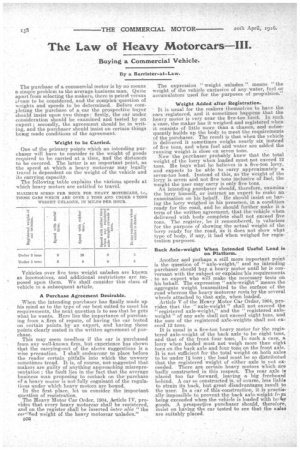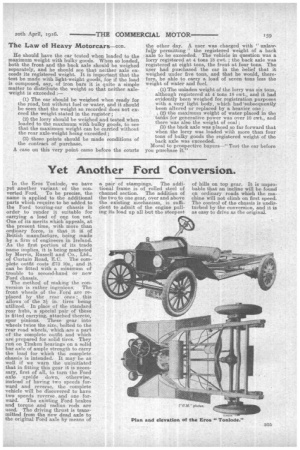The Law of Heavy Motorcars—III.
Page 18

Page 19

If you've noticed an error in this article please click here to report it so we can fix it.
Buying a Commercial Vehicle.
By a Barrister-at-Law.
The purchase of a commercial motor is by no means a simple problem to the average business man. Quite apart from selecting the makers, there is petrol versus /Assam to be considered, and the complex question of weights and speeds to be determined. Before completing the purchase of a car the prospective buyer should insist upon two things : firstly, the car under consideration should be examined and tested by an expert ; secondly, the agreement should be in writing, and the purchaser should insist on certain things being made conditions of the agreement.
Weight to be Carried.
One of the primary points which an intending purchaser will have to consider is the weight of goods required to be carried at a time, And the distances to be covered. The latter is an important point, as the speed at which a heavy motorcar may legally travel is dependent on the weight of the vehicle and its carrying capacity.
The following table explains the various speeds at which heavy motors are entitled to travel.
MAXIMUM SPEED PER HOUR FOR HEAVY MOTORCARS, i.e., THOSE CARS WHICH ARE OVER 2 TONS AND UNDER 6 TONS WEIGHT UNLADEN, IN MILES PER HOUR.
Vehicles over five tons weight unladen are known as locomotives, and additional restrictions are imposed upon them. We shall consider this class of i vehicle n a subsequent article.
A Purchase Agreement Desirable.
When the intending purchaser has finally made up his mind as to the type of car best suited to meet his requirements, the next question is to see that he gets what he wants. Here lies the importance of purchasing from a ,firm of repute, of having the ear tested on certain points, by an expert, and having those i points clearly stated n the written agreement of purchase.
This may seem needless if the car is purchased from any well-known firm, but experience has shown that the carrying-out of the above suggestions is a wise precaution. I shall endeavour to place before the reader certain pitfalls into which the unwary sometimes tread. It is, of course, not suggested that makers are guilty of anything approaching misrepresentation; the fault lies in the fact that the average business man proposing to embark on the purchase of a heavy 'motor is not fully cognisant of the regulations under which heavy motors are bound.
In the first place, let us consider the important question of registration.
The Heavy Motor Car Order, 1904, Article IV, provides that every heavy motorcar shall be registered, and on the register shall be inserted inter alio, "the cer+;fied weight of the heavy motorcar 'unladen."
The expression " weight unladen" means " the weight of the vehicle exclusive of any water, fuel or accumulators used for the purposes of propulsion."
Weight Added after Registration.
It is usual for the makers themselves to have the cars registered, and it sometimes happens that the heavy motor is very near the five-ton limit. In such a case, the maker has it weighed and registered when it consists of little more than a chassis, and subsequently builds up the body to meet the requirements of the purchaser. The result is that when the vehicle is delivered it sometimes weighs nearly six instead of five tons, and when fuel and water are added the running weight is close on seven tons. -.
Now the purchaser probably knew that the total weight of the lorry when loaded must not exceed 12 tons. He buys what he believes is a five-ton lorry, and expects to be able to carry approximately a seven-ton load. Instead of this as the Weight of the lorry is seven and not five tons inclusive of fuel, the weight the user may carry is only five tons. An intending purchaser should, therefore, examine the lorry himself, or instruct an expert to make an examination on his behalf. He should insist on having the lorry weighed in his presence, in a condition ready for the road, and he should further make it a term of the written agreement, that the vehicle when delivered with body .complete shall not exceed five tons. The register, be it remembered, is valueless for the purpose of showing the actual weight of the • lorry ready for the road, as it does not show what _ type of body, if any, it had when. weighed for registration purposes.
Back Axle-weight When Intended Useful Load is on Platform.
Another and perhaps a still more important point is the question of "axle-weight," and no intending purchaser should buy, a heavy motor until he is conversant with the subject or explains`his requirements to an expert who will make the necessary tests on his behalf. The expression "axle-weight" means the aggregate weight transmitted to the surface of the road whereon the heavy motorcar rests by the several wheels attached to that axle, when loaded. Article V of the Heavy Motor ear Order, 1904, provides that the " axle-weight " shall not exceed the "registered axle-weight," and the "registered axleweight " of any axle shall not exceed eight tons, and the sum of the registered axle-weights shall not exceed 12 tons.
It is usual in a five-ton heavy motor for the registered axle-weight of the back axle to he eight tons, and that of the front four tons. In such a case, a lorry when loaded must not weigh more than eight _ tons on the back axle and four tons on the front axle. It is not sufficient for the total weight on both axles to be under 1? tons ; the load must be so distributed that the registered weight of either axle is not exceeded. There are certain heavy motors which ire badly constructed in this respect. The rear axle is placed too far forward, leaving a big freeboaad behind. A car so constructed is, of course, less liable to strain its back, but great disadvantages result to the user. In a car of this construction, it is practically impossible to prevent the back axle-weight frrina being exceeded when the vehicle is loaded with be goy goods. A prospective purchaser should, therefore, insist on having the car tested to see that the wales are suitably placed.
He should have the car tested when loaded to the maximum weight with bulky goods. When so loaded, both the front and the back axle should be weighed separately, and he should see that neither axle exceeds its registered weight. It is important that the test be made with light-weight goods, for if the load is composed, say, of iron bars it is quite a simple matter to distribute the weight so that neither axleweight is exceeded :— (1) The ear should be weighed when ready for the road, but without fuel or water, and it should be seen that the weight so recorded does not exceed the weight stated in the register ; (2) the lorry should be weighed and tested when loaded to the maximum with bulky goods, to see that the maximum weight can be carried without the rear axle-weight being exceeded ; • (3) these points should be made conditions of the contract of purchase.
A case on this very point came before the courts
the other day. A user was charged with " unlawfully permitting" the registered weight of a back axle to be exceeded. The vehicle in question was a lorry registered at 4 tons 18 cwt. ; the back axle was registered at eight tons, the front at four tons. The user had purchased the car in the belief that it weighed under five tons and that he would, therefore, be able to carry a:load of seven tons less the weight of water and fueL (1)The unladen weight of the lorry was six tons although registered at 4 tons 18 cwt., and it had evidently been weighed for registration purposes with a very light body, which had 'subsequently been altered or replaced by a heavier one ;
. (2) the maximum weight of water placed in the tanks for generative power was over 10 cwt., and there was alao the weight of coal ; (3) the back axle was placed so far forward that when the lorry was loaded with more than four tons of bulky goods the registered weight of the back axle was exceeded.
Moral to prospective buyers—" Test the car before you purchase it.






















